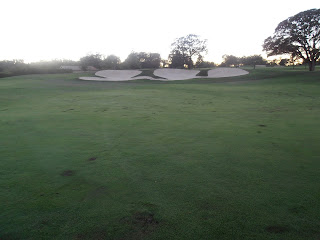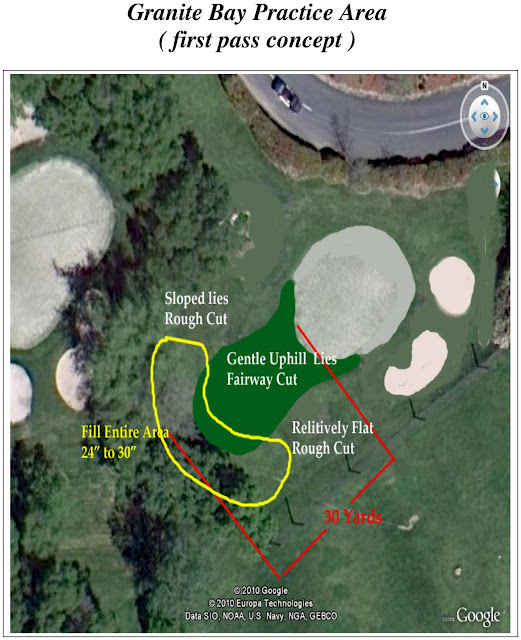One of the best things that can be done to sports turf such as golf course playing surfaces is core aeration because it addresses multiple issues. The process relieves soil compaction resulting from vehicle and foot traffic. It provides necessary air to the turfgrass root zone for basic plant physiological processes and maintains soil permeability providing a release passage for the carbon dioxide gasses produced by the roots in these processes. Finally core aeration removes the excessive organic layer or thatch that turf produces which is the culprit that seals the root zone off from atmospheric air to begin with. If it seems like a vicious circle, it is. Insert Granite Bays heavy decomposed granite soil along with high bentgrass population in the fairways and you have a even higher premium on getting this job done on a regular basis.
The actual process of aeration is not without its complications and is capable of temporarily harming as much as it helps. This is the reason why the job has to be done in a non stressful time of the year such as Spring and Fall facilitating rapid recovery. The quicker we can get the job done, the quicker the turf will recover and you can get back to playing on smooth surfaces.
| Recently core aerated green #12 |
With all of this in mind Granite Bay management, with the blessing of the Granite Bay Golf Committee, decided to expand some alternating front nine / back nine closures to help golf course maintenance get the job done to all of the playing surfaces in not only a expedient manner but producing a better quality job because we would not have to rush to remove wet cores ahead of play. Unfortunately some unexpected early season storms necessitated a change of plans although we were still able to make substantial progress and improvements over aeration seasons of the past.
Our original plan to aerate greens was to do the front nine on Tuesday the 4th and the back nine on Wednesday the 5th. A decent rainstorm was forecasted for Tuesday night through Wednesday so we decided to close the entire course and complete greens aeration on Tuesday ahead of the storm. This ended up being a good call as the rain started to fall as we were putting the finishing touches on #18 Tuesday evening. Ultimately the recovery of the greens went well. After 21 days aeration holes were completely covered, the greens were rolling smooth albeit not as fast as we would like but most importantly they are healthy going into the winter.
We were scheduled to aerate fairways with another alternating front nine / back nine closure immediately following greens aeration on Thursday & Friday but conditions were not dry enough to proceed. The following week we stayed on schedule despite more rain and aerated and over seeded the hybrid bermuda tees. The week of October 17th we were scheduled for our last front nine / back nine alternating closure to aerate around the green surrounds but instead had to use these scheduled dates to complete fairways due to being rained out two weeks prior.
| Just a minimal of cleanup following the core processor. |
For fairway aeration we borrowed a piece of equipment called a core processor. This machine picked up and ground into a fine topdressing the extracted cores from the aeration process. We divided manpower resources creating a early morning aerating crew and a afternoon / evening cleanup crew and core aerated all fairways in two days along with doing a much cleaner job. Fairway aeration alone would have normally taken two weeks to complete so in three weeks we completed greens, tees and fairways. Currently we are aerating a couple of green surrounds a day and cleaning up the mess in the midst of players. It will take us a couple of weeks with everything else we have to do to complete the surrounds. Finally we will start aerating the rough after that which will take another couple of weeks.
| Toro Core Processor converting plugs into usable topdressing |
Obviously the critical task of aeration requires much planing and preparation. However it is difficult to plan for everything such as weather or unforeseen equipment malfunctions. Additionally the process seems to create an environment conducive to an increase in skunk and raccoon activity particularly in the fall even with preventive treatments for the insects they long for. But even with these set-backs and unforeseen problems, we have made progress in this aeration season and it is my belief that with the proper equipment and a little luck from nature, we can aerate this entire property in 5 weeks. We'll give it a try again in the spring.
| Pretty substantial hydraulic leak from aeration equipment on the #3 green. Does not look too bad from this picture but this area would have died. |
| Current view after re-sodding the oil effected area. Temporarily mowing at a higher height of cut then the rest of the green allowing the new sod to root. |
Practice Area Progress
Establishment of the new turf in the recently renovated practice area is coming along well for most of the area. The hybrid bermuda that we established as a base from sprigs has exceeded our expectations and has rooted and created a very stable playing surface. It has recently been over-seeded with ryegrass to provide winter color as the hybrid will go at least partially dormant once we start to get some frost and real cold weather. Additionally the ryegrass will help define rough from the tighter mowed areas in front of the target green.
The expansion of the target green did not establish as rapidly as the rest of the area and still has a ways to go to be close to the quality of the greens on the rest of the the course. We are currently mowing it at a higher height of cut and have re-seeded and topdressed several times since initial seeding in late August. The cooler weather we are currently experiencing gives us better temperatures to work with and push the green towards usable establishment. Unfortunately there are too many areas on the green that are currently too thin to hold up to ball marks and foot traffic so we have to give it a few more weeks to further establish.
According to our own Craig Johns, "The Golf Committee is working on an event to celebrate the "official" opening of the remodeled Short Game Practice Area some time November that will provide some fun and interesting skills challenge competition….rumor has it that the Golf Channel is negotiating the television rights to "Big Break Granite Bay" to coincide with that….stay tuned for more information about the event."
Next After Aeration
After we complete the aeration of the green surrounds, which will be the week November 7th, we will start pruning and clearing brush. The first area we plan to tackle is area directly in front of the Granite & Tournament tees on #14 along with the vegetation blocking the right side of the hole from the Club & Pebble tees. We plan to make a major push on this kind of work throughout the course this fall and winter so many more details and before and after pictures to come.
| Very recent picture of the expanded target green in the practice area. Still not quite ready for extended use. |
Next After Aeration
After we complete the aeration of the green surrounds, which will be the week November 7th, we will start pruning and clearing brush. The first area we plan to tackle is area directly in front of the Granite & Tournament tees on #14 along with the vegetation blocking the right side of the hole from the Club & Pebble tees. We plan to make a major push on this kind of work throughout the course this fall and winter so many more details and before and after pictures to come.
Tee Rotation
One last thing that you will begin to notice today is that golf course maintenance has started a tee rotation schedule corresponding with our traditional pin rotation. This rotation is in response to a long standing member request and I must apologize that it has taken this long to get something done. The rotation does move blocks up and down on a regular basis on tees like #5, #6, #7, #14, and #18 mostly for Club and Granite teeing locations although Tournament and Pebble will have some different shifts in teeing area as well. As an example once in the six stage pin rotation the Club tees will be moved up to the 439 level on #18 as well as once in the rotation the Granite tees on #14 will be moved down to the 165 level. When these types of shifts occur we have signs that we will place on the tees directing members. I anticipate this being a work in progress for both the GCM staff and membership so bear with us and please provide feedback. The end result of this new rotation schedule should provide more variety for our membership along with rotating wear on our tee boxes by taking advantage of the various tee levels we have here at Granite Bay.
One last thing that you will begin to notice today is that golf course maintenance has started a tee rotation schedule corresponding with our traditional pin rotation. This rotation is in response to a long standing member request and I must apologize that it has taken this long to get something done. The rotation does move blocks up and down on a regular basis on tees like #5, #6, #7, #14, and #18 mostly for Club and Granite teeing locations although Tournament and Pebble will have some different shifts in teeing area as well. As an example once in the six stage pin rotation the Club tees will be moved up to the 439 level on #18 as well as once in the rotation the Granite tees on #14 will be moved down to the 165 level. When these types of shifts occur we have signs that we will place on the tees directing members. I anticipate this being a work in progress for both the GCM staff and membership so bear with us and please provide feedback. The end result of this new rotation schedule should provide more variety for our membership along with rotating wear on our tee boxes by taking advantage of the various tee levels we have here at Granite Bay.
| Example of signs we will use to direct members when tee markes are shifted to diffrent tee levels. |







